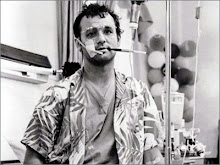What a piece of work this is.
Scott Pilgrim Versus The World is a one-of-a-kind experience. It is unpredictable. It is visually stunning, with constant wonderments both large and small. It is well acted across the board, and there are a couple of new faces here that are destined for big things. At times, the volume of gags recalls a Mad Magazine foldout; it’s that dense. Spaced/Shaun of the Dead/Hot Fuzz writer-director Edgar Wright has achieved some kind of tour de force with this film (his third). If I’m being honest with myself, I have to recommend that you see it, and on the biggest, best screen you can.
And if I’m lucky, I’ll never have to see it ever again. For all its many, many strengths, the film is, ultimately, about as useful as tits on a steer.
It’s hard to explain. The film does nothing "wrong.” Every element of the film has its own logic and works within the overall context of the film. After a while, I guess I just stopped caring.
In fact, I think it was right about the time Scott’s band went up against Evil Exes Five and Six (a pair of Asian electronica musicians) that I checked out for good. I saw a Forbidden Planet-esque Id Monster spring from the sheer power of the Sex Bob-ombs rock and do battle with a pair of twin dragons that the twins’s trance-pop beat unleashed, and I thought, "Well, this is pointless."
Essentially, you have two movies here. The first is a whimsically absurdist indie romp. Think Garden State, but with a sharper comic edge and zero sentimentality (actually, I’ll revise—think Wright’s TV show, Spaced). For all the movie/music/video game/comic book references in this first movie, its heart lies in the interactions of a bunch of (mostly) aimless Canadian twenty-somethings as they shoot the shit with each other.
And I am fine with that. The pleasures in this part of the film are modest, and Wright and Co. seem to be quite content, for about forty minutes or so, at producing this wry, de-caffeinated vibe. The little bursts of visual and sonic flare (noxious pink fumes emerging from Scott’s teenage girlfriend’s mouth at her declaration of love for him, a ‘60s Batman-style “Bang” appearing besides the band drummer’s head when she pantomimes shooting herself) add just the right amount of surreal emphasis to the deadpan performances of the cast. It’s a good thing.
And then an Indian dude crashes through the ceiling to attack Michael Cera in a fight scene equal parts inspired by Dragonball Z, Final Fantasy X, Mortal Kombat, Street Fighter, Super Smash Brothers, and a Bollywood musical, and I began to check out.
From minute forty-one until the end, the film becomes one, long, relentless stretch of bouncy combat scenes as Scott brawls his way through the roster of his new (more age appropriate) girlfriend’s ex boyfriends. The quality of these scenes is still top-shelf, and I’d wager that, taken out of context, they’d make for thrilling viewing (this movie will play like gangbusters on You Tube, neatly chopped into five-minute chunks). But strung along, they begin to wear on you. The delights of this new film—the music, the fight choreography, Chris Evans’s knowingly dopey action movie star, Jason Schwartzman’s brilliant turn as the Big Bad of the movie—come at you fast and hard, and they overwhelm everything that was sly and low-key and knowing about the first forty minutes.
It becomes too much, and, strangely, it doesn’t fit. Even though Wright has established his world as one where anything can—and does—happen (this isn’t a dreamscape a la Inception), the fight scenes don’t sync up with the whole picture. Part of that is surface glare; we go from watching a movie that looks like it cost maybe two grand to a multimillion dollar mega-blockbuster in a split-second, a surefire move to create tonal whiplash if I ever saw one.
But that surface disparity stands indicative of a bigger issue. This is a movie that, at its core, concerns itself with small matters of the heart. How to give love, how to receive it, how to deal with love’s past scars, and how to gain the personal responsibility necessary for struggling through all that pain.
And gosh, I can’t think of a better way to dramatize those sensitive issues than by making a frenetic video game farrago where characters emulate fighters from Tekken as they beat one another into literal coins.
I get what Wright is going for. Both Shaun of the Dead and Hot Fuzz had the same aim—to use fantasy as a means for depicting emotional growth—and they succeeded marvelously. The difference in both those instances? Wright kept the stakes high on both fronts. Shaun desperately needs to grow up, and he’s got to gain maturity while evading zombies that want to peel the flesh from his bones. Sgt. Angel has to make an emotional connection to the world, and people are trying to shoot him/stab him/drop-a-church-spire-on-his-head at every step of his inner journey.
The over-the-top video game mechanics of Scott Pilgrim ruin that balance. I get that all the fights are literal, that if you die enough times, you really are dead. I get the figurative significance they have as well—Scott working through his girlfriend’s/his baggage. But the fight scenes never feel real, even in the unreality Wright has worked so hard to define. They never feel dangerous. And they are so outlandish that they obliterate the delicate emotions they should be elevating.
End result: what you’ve got here is a gorgeously wrought, thrillingly executed Jack-in-the-Box. Works beautifully and has zero lasting emotional power, which wouldn’t be such a big deal if it didn’t want to, you know, have lasting emotional power.
If nothing else, now I know how people who don't like The Life Aquatic with Steve Zissou felt when they first saw it.
Subscribe to:
Post Comments (Atom)

No comments:
Post a Comment